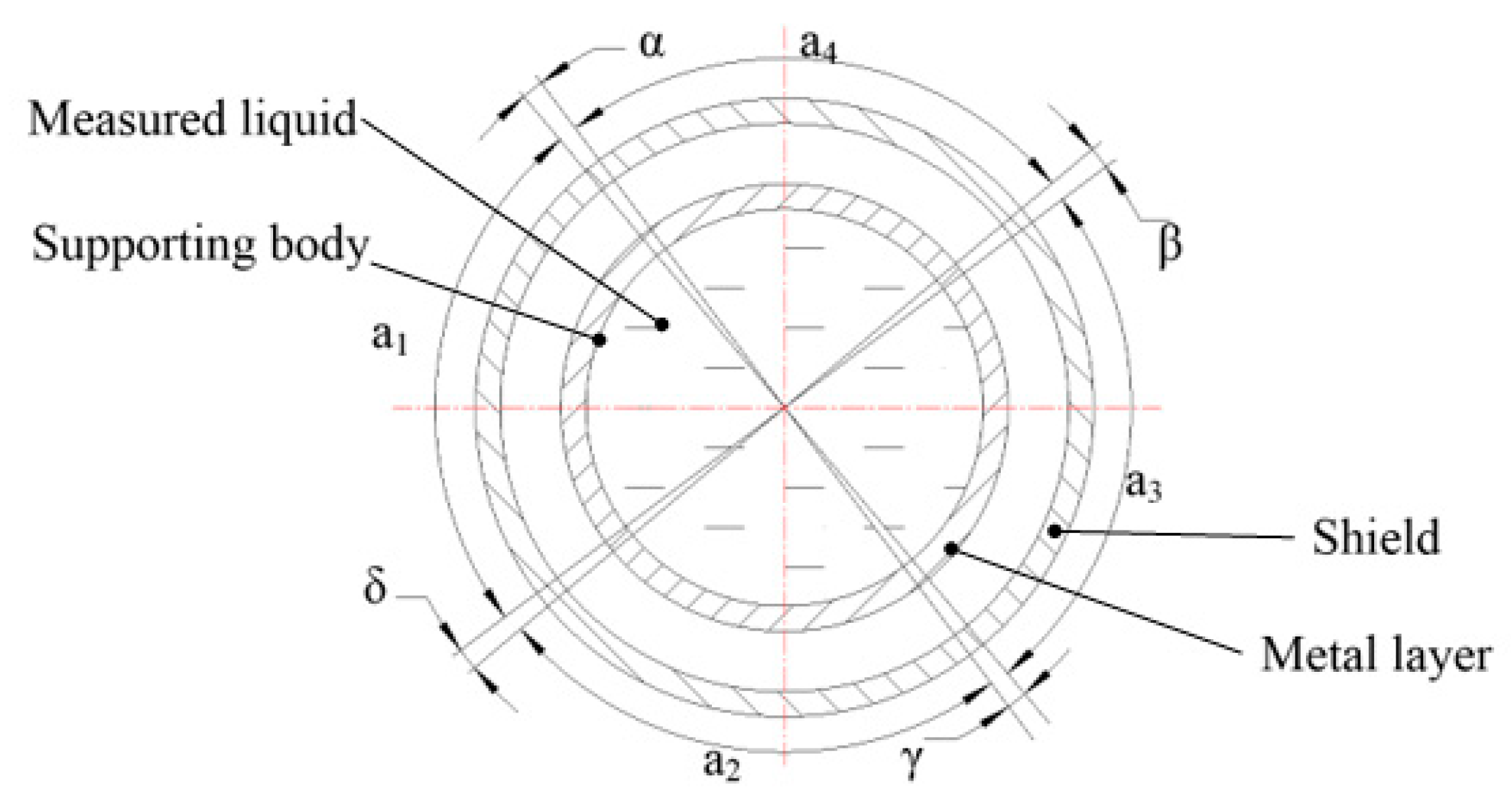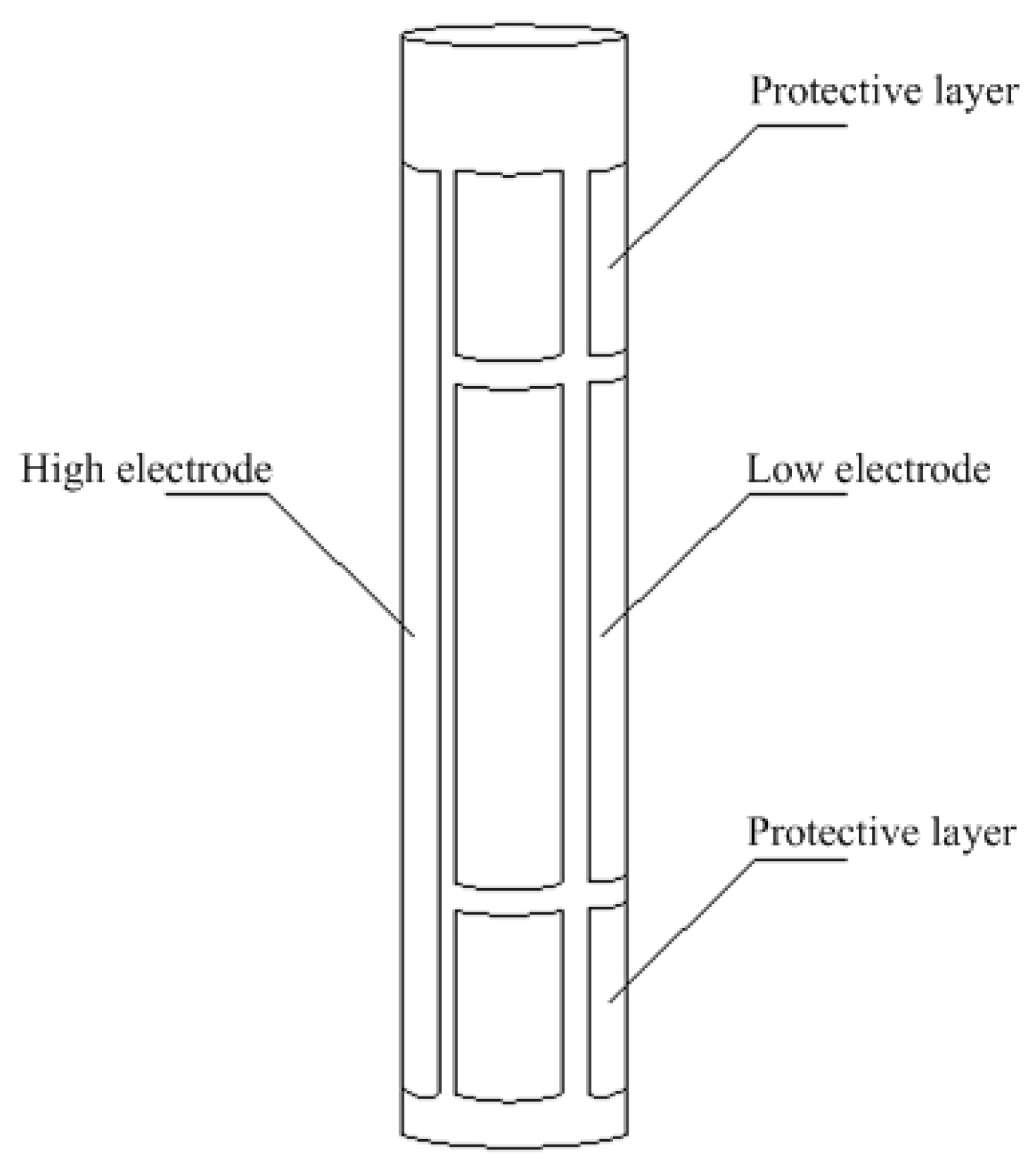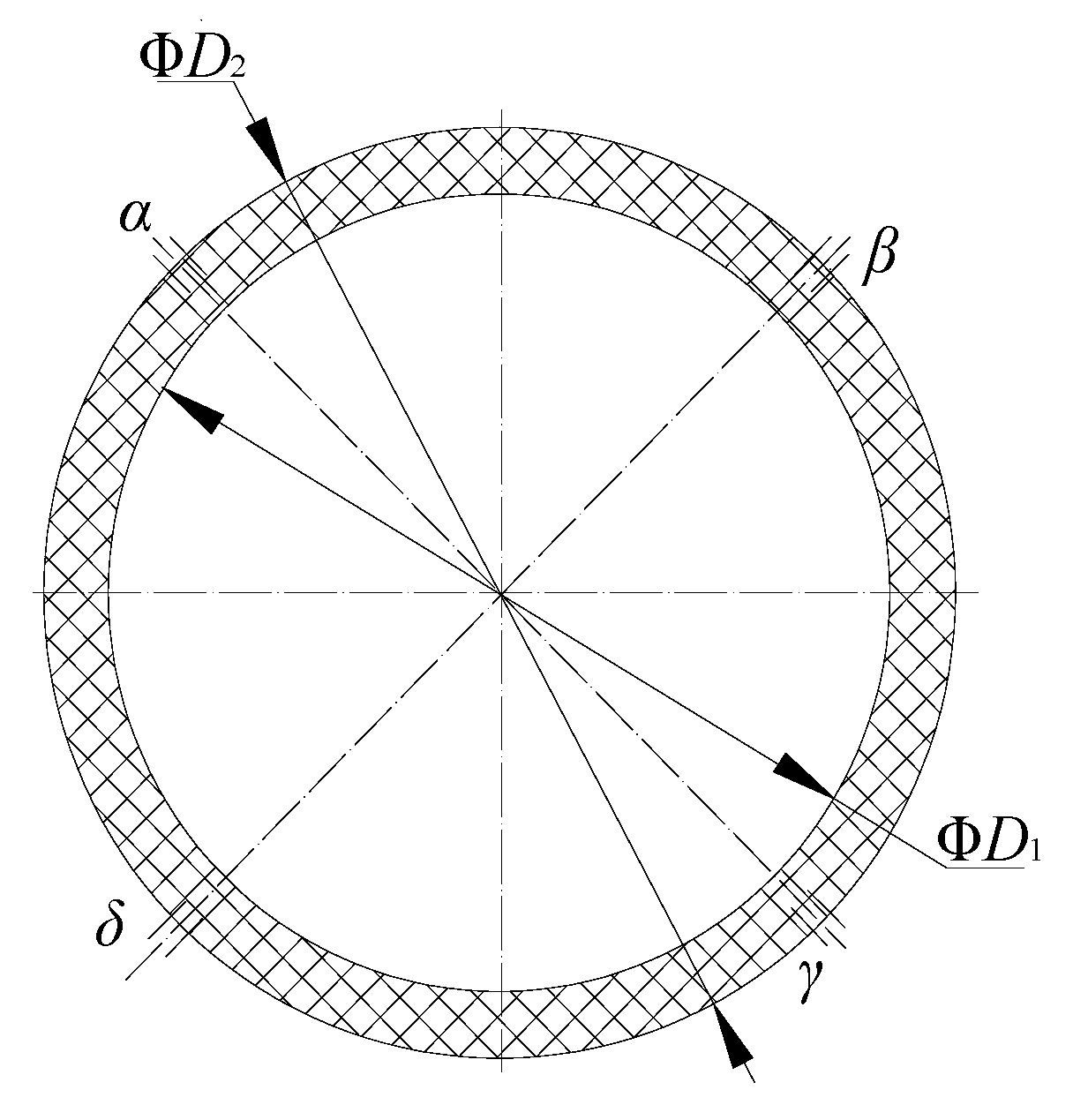Design and Characteristic Analysis of Cross-Capacitance Fuel-Level Sensor
Abstract
:1. Introduction
2. Principle of Cross-Capacitance Liquid-Level Sensor
- 1)
- The output capacitance of the empty tube is given by
- 2)
- The output capacitance of the full tube is given by
- 3)
- When the level of liquid fuel is lx, the cross-capacitive level sensor can be assumed as two upper and lower cross-capacitors. The upper part comprises cross-capacitor 1 with height l − lx, and the lower part comprises cross-capacitor 2 with liquid level lx. The medium to be measured is the liquid fuel to be tested. The capacitances of the two cross-capacitors are given bywhere and are the dielectric constants of air and the liquid fuel to be tested respectively. is the correction coefficients of air. is the correction factor of the output capacitor in a medium with dielectric constant . When an insulating tube is placed in a single-tube cross capacitor, there is a certain difference between the output capacitors, and the correction coefficients can be used.
3. Design of a Capacitive Fuel Sensor
4. Experimental Characteristics of the Sensor
4.1. Linearity Experiment
4.2. Repeatability Experiment
4.3. Hysteresis Test
5. Conclusions
- 1)
- Based on the cross-capacitance principle, we designed a new single-tube cross-capacitive fuel-level sensor.
- 2)
- A fuel-level measurement model was established for the developed sensor, and the relationship between the measured liquid level and sensor output capacitance was derived. The feasibility of applying the capacitance principle to the measurement of fuel level was theoretically proved.
- 3)
- The characteristics of the sensor were tested experimentally, and the linearity, repeatability, and hysteresis of the designed sensor were examined. The experimental results showed that the linearity error in the single-tube calculation for the liquid-level sensor was ±0.48%, the repeatability error was ±0.47%, and the hysteresis error was ±0.68%.
- 4)
- The cross-capacitive fuel-level sensor developed in this study provides not only a new idea for the application of the capacitance principle to sensors but also a basis for the development of high-precision liquid-level sensors.
Author Contributions
Funding
Conflicts of Interest
References
- Small, G.W.; Fiander, J.W. Fabrication and Measurement of the Main Electrodes of the NMIA-BIPM Calculable Cross Capacitors. IEEE Trans. Instrum. Meas. 2011, 60, 2489–2494. [Google Scholar] [CrossRef]
- Hunag, L.; Small, G.W.; Lu, Z.; Fiande, J.R.; Yang, Y. Model Tests of Electrical Compensation Method for the New Calculable Cross-Capacitor at NIM. IEEE Trans. Instrum. Meas. 2013, 62, 1789–1794. [Google Scholar] [CrossRef]
- Terzic, E.; Nagarajah, C.R.; Alamgir, M. Capacitive sensor-based fluid level measurement in a dynamic environment using neural network. Eng. Appl. Artif. Intell. 2010, 23, 614–619. [Google Scholar] [CrossRef]
- Lee, R.D.; Kim, H.J.; Semenov, Y.P. Precise measurement of the dielectric constants of liquids using the principle of cross capacitance. IEEE Trans. Instrum. Meas. 2001, 4, 298–301. [Google Scholar]
- Niu, Z.; Zhao, Y.; Tian, B.; Guo, F. The novel measurement method of liquid level and density in airtight container. Rev. Sci. Instrum. 2012, 83, 125108. [Google Scholar] [CrossRef] [PubMed]
- Reverter, F.; Li, X.; Meijer, G.M. Liquid-level measurement system based on a remote grounded capacitive sensor. Sens. Actuators A Phys. 2007, 138, 1–8. [Google Scholar] [CrossRef]
- Yang, C.N.; Chen, S.P.; Yang, G.G. Fiber optical liquid level sensor under cryogenic environment. Sens. Actuators 2001, 94, 69–75. [Google Scholar] [CrossRef]
- Singh, H.K.; Chakroborty, S.K.; Talukdar, H.; Singh, N.M.; Bezboruah, T. A new non-intrusive optical technique to measure transparent liquid level and volume. IEEE Sens. J. 2011, 11, 391–398. [Google Scholar] [CrossRef]
- Nakagawa, T.; Hyodo, A.; Kogo, K.; Kurata, H.; Osada, K.; Oho, S. Contactless liquid-level measurement with frequency-modulated millimeter wave through opaque container. IEEE Sens. J. 2013, 13, 926–933. [Google Scholar] [CrossRef]
- Lu, G.; Chen, S. A Capacitive Liquid Level Sensor with Four Electrodes. In Proceedings of the 3rd International Conference on Computer Science and Information Technology, Chengdu, China, 9–11 July 2010; pp. 628–632. [Google Scholar]
- Stanley, E.W.; Bryant, D.T. A wireless fluid-level measurement technique. Sens. Actuators A Phys. 2007, 137, 268–278. [Google Scholar] [Green Version]
- Mou, C.B.; Zhou, K.M.; Yan, Z.J.; Fu, H.; Zhang, L. Liquid level sensor based on an excessively tilted fiber grating. Opt. Commun. 2013, 305, 271–275. [Google Scholar] [CrossRef]
- Dai, Y.; Tan, S.; Sun, Q.; Wo, J.; Xu, Z.; Liu, D. Simultaneous measurement for liquid level and refractive index based on all-fiber modal interferometer. J. Mod. Opt. 2013, 60, 496–502. [Google Scholar] [CrossRef]
- Bande, V.; Ciascai, I.; Pitica, D. Low-cost capacitive sensor for wells level measurement. In Proceedings of the 33rd International Spring Seminar on Electronics Technology, Warsaw, Poland, 12–16 May 2010; pp. 279–283. [Google Scholar]
- Lampard, D.G.; Cutkosky, R.D. Some results on the cross-capacitances per unit length of cylindrical three-terminal capacitors with thin dielectric films on their electrodes. Proc. IEE Part C Monogr. 1960, 107, 112–119. [Google Scholar] [CrossRef]








© 2018 by the authors. Licensee MDPI, Basel, Switzerland. This article is an open access article distributed under the terms and conditions of the Creative Commons Attribution (CC BY) license (http://creativecommons.org/licenses/by/4.0/).
Share and Cite
Yu, J.; Yu, H.; Li, D. Design and Characteristic Analysis of Cross-Capacitance Fuel-Level Sensor. Sensors 2018, 18, 3984. https://doi.org/10.3390/s18113984
Yu J, Yu H, Li D. Design and Characteristic Analysis of Cross-Capacitance Fuel-Level Sensor. Sensors. 2018; 18(11):3984. https://doi.org/10.3390/s18113984
Chicago/Turabian StyleYu, Jing, Hang Yu, and Dongsheng Li. 2018. "Design and Characteristic Analysis of Cross-Capacitance Fuel-Level Sensor" Sensors 18, no. 11: 3984. https://doi.org/10.3390/s18113984



